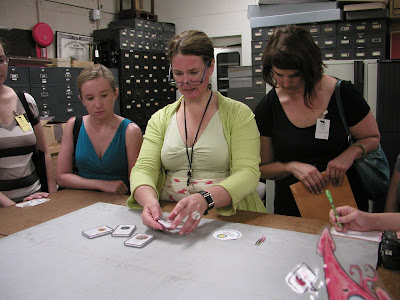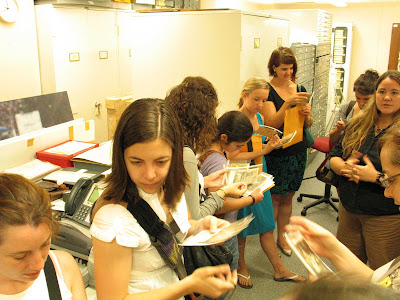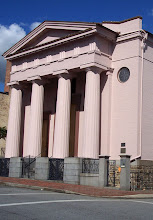
Before we even headed south to DC, we decided to have a little fun with our interns. Each was given a mysterious packet, not to be opening until we were standing in front of the NMAH! Reportedly the temptation to open their packets early was high, but happily they all held out.

One of the items in their packets was a list of "missions," small tasks to accomplish throughout there day. One mission asked them to check out the
"Read My Pins" exhibit in the Smithsonian Castle and choose their favorite pin (and tell us when/why they would wear it)!
 My personal favorite, doesn't it just seem super useful?
My personal favorite, doesn't it just seem super useful?Liberty, 1997. Gijs Bakker, Netherlands. Sterling silver, stainless-steel watches.
4.2” x 3.6” (10.7cm x 9.2cm). Photo by John Bigelow Taylor
At
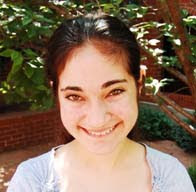
Read My Pins at the Smithsonian Castle, my favorite pin that Madeline Albright wore was the Heart pin, “Katie’s Heart.” I would wear the pin because of the meaningful significance attached to it, as it was given to Madeline Albright by her daughter, Katie, which represents love as well as the bonds that can be made between different generations. I think it is really special that Madeline Albright continues to treasure this pin as much as she has always done because it

signifies the everlasting mother-daughter bond that the two of them have. If I had a heart pin like this, I would wear it all the time, just like Madeline Albright does, to represent my special relationship with my daughter.
Katie’s Heart, 1972. Katie Albright, USA. Clay. 2.8” x 2.4” (7.2cm x 6cm). Photo by John Bigelow Taylor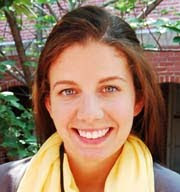
My favorite Madeline Albright pins depicted animals. I love animal jewelry and I would be thrilled to have any of the pins pictured above in MY own private collection… but alas for now (and probably forever) I will have to merely daydream about wearing any one of the pins above. My favorite pin is black, circular,
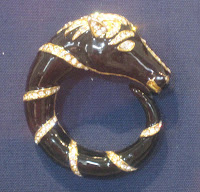
and features an animal head. I like that particular pin because it is open to interpretation as to what animal it depicts, and because I like the contrast between the bright stripes and the dark black circle. If I owned this pin, I would wear it all of the time… to bed, in the shower, when running a marathon, etc., etc.


I realize that it is probably supposed to be a palm tree pin, but I would like to think that it is really a palmetto tree pin, as I am from the Palmetto State. We South Carolinians have a lot of state pride and often wear various types of Palmetto tree clothing, shoes, bumper stickers, etc.

I feel that this lipstick pin would be appropriate for so many occasions. I was attracted most by its sass and sparkle, and by its color: bright shiny red. I like to think of Madeleine Albright putting on her shiny red lipstick and her shiny red lipstick

pin and going out on the town with foreign dignitaries and heads of state. I’d like to emulate that kind of verve in my life as well. I’d probably wear this pin on the lapel of the nice fitted jacket of my power suit, were I to have one, and clearly I am going to need one if I am to be more like Ms. Albright.


I would love to wear this with my Renaissance costumes or for a special occasion!

Ever since I was a small child, my family has owned a fish tank. We owned the gamut--salt water, fresh water, tropicals, octopus, anemonies, piranhas-

- you name it, we had it. I still love fish to this day, and must always have a tank set up; even if it is a small one gallon tank with a beta. My favorite Albright pin is the colorful fish in the upper right corner. (This is a salt-water fish, however I do not recall the name, but trust me, we owned one!)
 The National Museum of African Art
The National Museum of African Art


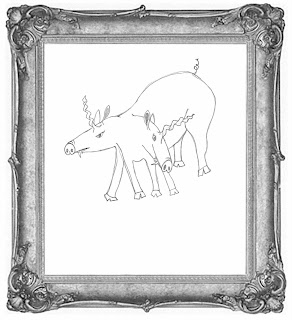



 OVE Daffy Duck, and after having seen the cute, tiny ducklings snoozing in the Sculpture Gallery water fountain, I thought of one of my favorite Daffy moments, where he and Bugs Bunny find a treasure cave where Daffy greedily tries to steal everything. A magic Genie eventually shrinks him into a tiny version of himself (much like the Liliputian ducklings), where we see him attempting to abscond a pearl.
OVE Daffy Duck, and after having seen the cute, tiny ducklings snoozing in the Sculpture Gallery water fountain, I thought of one of my favorite Daffy moments, where he and Bugs Bunny find a treasure cave where Daffy greedily tries to steal everything. A magic Genie eventually shrinks him into a tiny version of himself (much like the Liliputian ducklings), where we see him attempting to abscond a pearl.





















